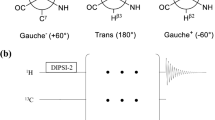Abstract
For several of the proteins in the BioMagResBank larger than 200 residues, 60 % or fewer of the backbone resonances were assigned. But how reliable are those assignments? In contrast to complete assignments, where it is possible to check whether every triple-resonance Generalized Spin System (GSS) is assigned once and only once, with incomplete data one should compare all possible assignments and pick the best one. But that is not feasible: For example, for 200 residues and an incomplete set of 100 GSS, there are 1.6 × 10260 possible assignments. In “EZ-ASSIGN”, the protein sequence is divided in smaller unique fragments. Combined with intelligent search approaches, an exhaustive comparison of all possible assignments is now feasible using a laptop computer. The program was tested with experimental data of a 388-residue domain of the Hsp70 chaperone protein DnaK and for a 351-residue domain of a type III secretion ATPase. EZ-ASSIGN reproduced the hand assignments. It did slightly better than the computer program PINE (Bahrami et al. in PLoS Comput Biol 5(3):e1000307, 2009) and significantly outperformed SAGA (Crippen et al. in J Biomol NMR 46:281–298, 2010), AUTOASSIGN (Zimmerman et al. in J Mol Biol 269:592–610, 1997), and IBIS (Hyberts and Wagner in J Biomol NMR 26:335–344, 2003). Next, EZ-ASSIGN was used to investigate how well NMR data of decreasing completeness can be assigned. We found that the program could confidently assign fragments in very incomplete data. Here, EZ-ASSIGN dramatically outperformed all the other assignment programs tested.




Similar content being viewed by others
References
Bahrami A, Assadi AH, Markley JL, Eghbalnia HR (2009) Probabilistic interaction network of evidence algorithm and its application to complete labeling of peak lists from protein NMR spectroscopy. PLoS Comput Biol 5(3):e1000307
Bertelsen EB, Chang L, Gestwicki JE, Zuiderweg ER (2009) Solution conformation of wild-type E. coli Hsp70 (DnaK) chaperone complexed with ADP and substrate. Proc Natl Acad Sci USA 106:8471–8476
Buchler N, Wang H, Zuiderweg ERP, Goldstein RA (1997) Protein heteronuclear NMR assignments using mean-field simulated annealing. J Magn Reson 125:34–42
Crippen GM, Rousaki A, Revington M, Zhang Y, Zuiderweg ER (2010) SAGA: rapid automatic mainchain NMR assignment for large proteins. J Biomol NMR 46:281–298
Frueh DP, Arthanari H, Koglin A, Walsh CT, Wagner G (2009) A double TROSY hNCAnH experiment for efficient assignment of large and challenging proteins. J Am Chem Soc 131:12880–12881
Goddard TD, Kneller DG (2000) SPARKY 3. University of California, San Francisco
Hyberts SG, Wagner G (2003) IBIS—a tool for automated sequential assignment of protein spectra from triple resonance experiments. J Biomol NMR 26:335–344
Jung Y-S, Zweckstetter M (2004) Mars—Robust automatic backbone assignment of proteins. J Biomol NMR 30:11–23
Kay LE, Ikura M, Tschudin R, Bax A (1990) 3-Dimensional triple-resonance NMR-spectroscopy of isotopically enriched proteins. J Magn Reson 89:496–514
Mayer MP, Bukau B (2005) Hsp70 chaperones: cellular functions and molecular mechanism. Cell Mol Life Sci 62:670–684
Montelione GT, Wagner G (1990) Conformation-independent sequential NMR connections in isotope-enriched polypeptides by 1H–13C–15N triple-resonance experiments. J Magn Reson 87:183–188
Moseley HN, Monleon D, Montelione GT (2001) Automatic determination of protein backbone resonance assignments from triple resonance nuclear magnetic resonance data. Methods Enzymol 339:91–108
Zimmerman DE, Kulikowski CA, Huang Y, Feng W, Tashiro M, Shimotakahara S, Chien C, Powers R, Montelione GT (1997) Automated analysis of protein NMR assignments using methods from artificial intelligence. J Mol Biol 269:592–610
Zuiderweg ER, Bertelsen EB, Rousaki A, Mayer MP, Gestwicki JE, Ahmad A (2013) Allostery in the Hsp70 chaperone proteins. Top Curr Chem 328:99–153
Acknowledgments
E.R.P.Z. acknowledges support from National Institutes of Health grant NS059690 (to G.E. Gestwicki, P.I.). I.B. was supported by National Institutes of Health grant HL 102662 (to S. Ragdale, P.I.); P.R. was supported by National Institutes of Health grant AI094623 (to C. G. Kalodimos, P.I.). The authors acknowledge N.K. Khanra (Rutgers) for the type III ATPAse sample preparation and helpful discussions.
Author information
Authors and Affiliations
Corresponding author
Electronic supplementary material
Below is the link to the electronic supplementary material.
Rights and permissions
About this article
Cite this article
Zuiderweg, E.R.P., Bagai, I., Rossi, P. et al. EZ-ASSIGN, a program for exhaustive NMR chemical shift assignments of large proteins from complete or incomplete triple-resonance data. J Biomol NMR 57, 179–191 (2013). https://doi.org/10.1007/s10858-013-9778-y
Received:
Accepted:
Published:
Issue Date:
DOI: https://doi.org/10.1007/s10858-013-9778-y




